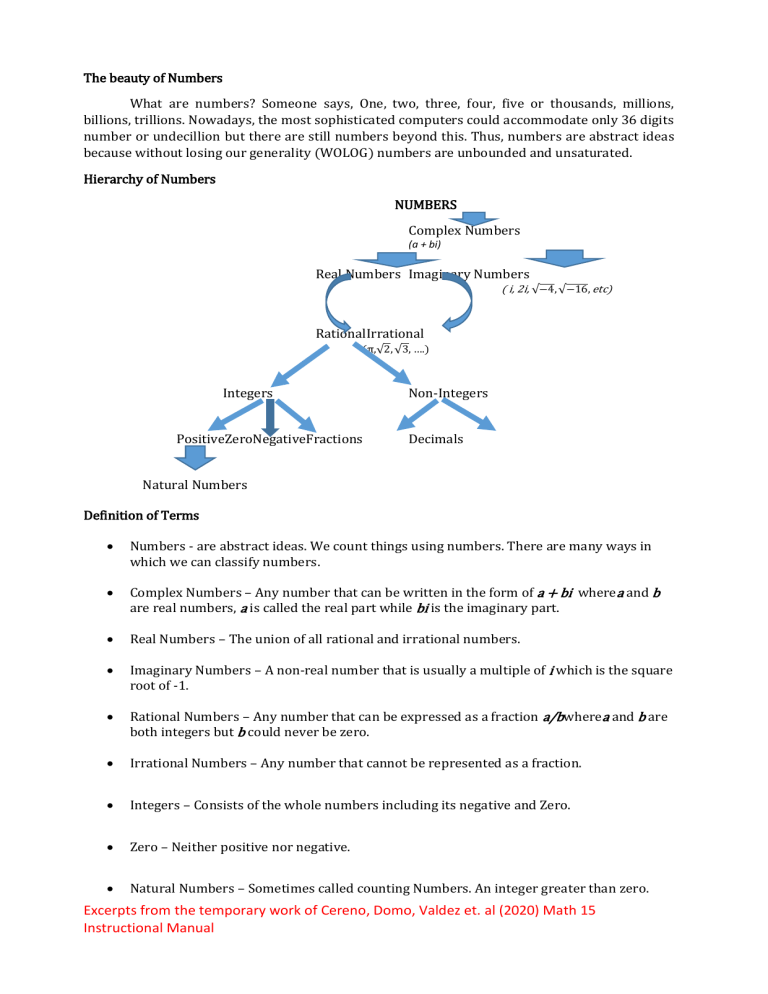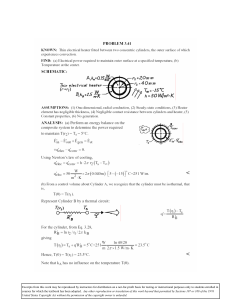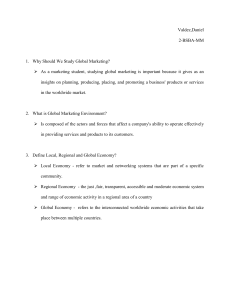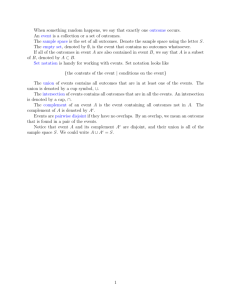
The beauty of Numbers
What are numbers? Someone says, One, two, three, four, five or thousands, millions,
billions, trillions. Nowadays, the most sophisticated computers could accommodate only 36 digits
number or undecillion but there are still numbers beyond this. Thus, numbers are abstract ideas
because without losing our generality (WOLOG) numbers are unbounded and unsaturated.
Hierarchy of Numbers
NUMBERS
Complex Numbers
(a + bi)
Real Numbers Imaginary Numbers
( i, 2i, √−4, √−16, etc)
RationalIrrational
(π,√2, √3, ….)
Integers
PositiveZeroNegativeFractions
Non-Integers
Decimals
Natural Numbers
Definition of Terms
Numbers - are abstract ideas. We count things using numbers. There are many ways in
which we can classify numbers.
Complex Numbers – Any number that can be written in the form of a + bi wherea and b
are real numbers, a is called the real part while bi is the imaginary part.
Real Numbers – The union of all rational and irrational numbers.
Imaginary Numbers – A non-real number that is usually a multiple of i which is the square
root of -1.
Rational Numbers – Any number that can be expressed as a fraction a/bwherea and b are
both integers but b could never be zero.
Irrational Numbers – Any number that cannot be represented as a fraction.
Integers – Consists of the whole numbers including its negative and Zero.
Zero – Neither positive nor negative.
Natural Numbers – Sometimes called counting Numbers. An integer greater than zero.
Excerpts from the temporary work of Cereno, Domo, Valdez et. al (2020) Math 15
Instructional Manual
Numbers’ Name based on the number of zeros
The digit zero plays a gigantic role as we count very large number. It helps to track these
multiples of 10 because the larger the number is, the more zeros are needed.
Name
Ten
Hundred
Thousand
Ten Thousand
Hundred Thousand
Million
Billion
Trillion
Quadrillion
Quintillion
Sextillion
Septillion
Octillion
Nonillion
Decillion
Undecillion
Duodecillion
Tredecillion
Quattuordecillion
Quindecillion
Sexdecillion
Septen-decillion
Octodecillion
Novemdecillion
Vigintillion
Centillion
Googol
Googolplex
Number of zeros
1
2
3
4
5
6
9
12
15
18
21
24
27
30
33
36
39
42
45
48
51
54
57
60
63
303
100
Scientific Notations
1 x 101
1 x 102
1 x 103
1 x 104
1 x 105
1 x 106
1 x 109
1 x 1012
1 x 1015
1 x 1018
1 x 1021
1 x 1024
1 x 1027
1 x 1030
1 x 1033
1 x 1036
1 x 1039
1 x 1042
1 x 1045
1 x 1048
1 x 1051
1 x 1054
1 x 1057
1 x 1060
1 x 1063
1 x 10303
1 x 10100
1 x 10googol
Remarks: Scientific Notation is a way of expressing numbers that are too big or too small to be
conveniently written in decimal. It is commonly used by scientists, mathematicians and engineers
in particular because it can simplify certain arithmetic operations.
Excerpts from the temporary work of Cereno, Domo, Valdez et. al (2020) Math 15
Instructional Manual
Chapter II
MATHEMATICAL LANGUAGE AND SYMBOLS
Characteristics of Mathematical Language
Expressions vs. Sentences
The mathematical term expression is equivalent to an English phrase. The most common
mathematical statements or sentences are called equations and inequalities.
Sentence
Expression
•
An equation is a SENTENCE.
•
solves an equation.
•
An equation HAS a relation symbol (i.e.,
=,>,<)
Ex. Ten is five less than a number.
10 = 𝑥 − 5
A number is less than five.
𝑥 < 5
•
An expression is a PHRASE,
a sentence fragment.
•
simplifies an expression.
•
An expression HAS NO relation
symbol.
Ex. five less than a number
𝑥 − 5
Conventions in the mathematical language
Symbols/Operations
Basic English Terms
=
Equals, is equal to (common mistake, “is equals to”), represents, is the
same as, is, are and the conjugations of the verb, “to be”, is similar to, is
equivalent to, exactly, results in.
+
Plus, sum, total, added to, added with, added by, augmented, raised,
more, more than, and, increased, put together.
−
Minus, difference, subtracted from, subtracted by, diminish, less, less
than, decreased, separated.
𝑜𝑟 ()
Times, product, multiplied by, multiplied with, multiplied to, doubled,
tripled, twice, thrice, etc.
/, ÷
Divided by, quotient, per, ratio, halved, over, over all.
Conversion of English expressions to mathematical sentences and vice-versa
Basic Mathematical
Statements
English Translation
Excerpts from the temporary work of Cereno, Domo, Valdez et. al (2020) Math 15
Instructional Manual
3+4 =7
•
Three plus four equals seven.
•
Three plus four is equal to seven.
•
Three increased by seven is four.
•
Three augmented by four equals seven.
Common errors:
10 − 2 = 8
•
Three plus four is equals to seven. (Grammar)
•
The sum of three and four equal to seven. (Grammar)
•
Ten minus two is eight.
•
Ten less two is eight.
•
Two less than ten is equal to eight.
•
The difference of ten and two is eight.
Common errors:
Basic Mathematical
Statements
7(2) = 14
•
Ten less than two is eight. (Connotes different meaning)
•
The difference of two and ten is eight. (Connotes
different meaning)
English Translation
•
Seven times two is fourteen.
•
The product of seven and two is fourteen.
•
Twice the number seven is fourteen.
Common errors:
6÷2= 3
•
Double the seven is fourteen. (Grammar)
•
Twice the product of two and seven is fourteen.
(Redundant)
•
Six divided by 2 is three.
•
The quotient of six and two is three.
•
The ratio of six and two is equal to three.
Common errors:
•
The quotient of two and six is three. (Connotes different
meaning)
•
The ratio of two and six is equal to three. (Connotes
different meaning)
Excerpts from the temporary work of Cereno, Domo, Valdez et. al (2020) Math 15
Instructional Manual
6+2
=2
4
•
The sum of six and two all over four is two.
•
The ratio of six plus two, and four is equal to two.
•
Two is the quotient if the sum of six and two is divided by
four.
Common errors:
2(12 − 4) = 16
•
Six plus two divided by four is two. (Connotes different
meaning)
•
Twice the difference of twelve and four is sixteen.
Common errors:
2𝑥 = 14
3(2𝑥 − 1) = 4
2(𝑥 + 1)
=5
3
•
Double the difference of twelve and four is sixteen.
(Connotes different meaning)
•
Twelve minus four times two is sixteen. (Connotes
different meaning)
•
Twice a number is equal to fourteen.
•
Two times a number is fourteen.
•
Thrice the difference of twice a number and one is four.
•
Three, multiplied to the difference of twice a number and
one, is four.
•
The ratio of twice the sum of a number and one, and three
is equal to five.
SETS
The concept of set formalizes the idea of grouping objects together and viewing them as a
single identity. A set is a collection of well-defined objects. The objects that belong in a set are the
elements, or members, of the set. Sets are usually denoted by capital letters ,,, … and elements are
usually denoted by small letters 𝑎,𝑏,𝑐, … .
There are many examples of sets. The following are sets:
1)
2)
3)
4)
5)
The numbers 1, 3, 7, and 10.
The solutions if the equation 𝑥 2 + 4𝑥 + 2 = 0.
The vowels of the English alphabet: a, e, i, o u.
The cities of Mindanao.
The even integers.
In many areas of mathematics, the following sets of numbers are extensively used:
Natural Numbers or Counting Numbers ℕ = {1, 2, 3, 4, 5, … }
Whole Numbers 𝑊 = {0, 1, 2, 3, 4, 5, … }
Integers ℤ = {. . . , − 4, −3, −2, −1, 0, 1, 2, 3, 4, . . . }
Rational Numbers ℚ= the set of all terminating or repeating decimals
Excerpts from the temporary work of Cereno, Domo, Valdez et. al (2020) Math 15
Instructional Manual
Irrational Numbers 𝐼= the set of all nonterminating, nonrepeating decimals
Real Numbers ℝ =the set of all rational or irrational numbers
There are two ways of describing a set:
1) Roster/Listing Method/Tabular Form. In this method, a set is described by listing element,
separated by commas, within braces.
e.g.
𝐴 = {𝑎, 𝑒, 𝑖, 𝑜, 𝑢}
𝐵 = {1, 2, 3, 4, 5, 6}
2) Set Builder/Rule Method. In this method, we write down a property or rule which gives us
all the elements of the set by that rule. Useful in describing infinite sets.
e.g.
𝐴 = {𝑥:𝑥 𝑖𝑠 𝑎 𝑣𝑜𝑤𝑒𝑙 𝑜𝑓 𝐸𝑛𝑔𝑙𝑖𝑠ℎ 𝑎𝑙𝑝ℎ𝑎𝑏𝑒𝑡𝑠}
𝐵 ={𝑥|𝑥∈𝑁 𝑎𝑛𝑑 𝑥>7}
Types of Set
1) Finite Set. A set containing finite number of elements or no element.
e.g.
B = {1,2,3,4,5 }
𝐴 = {𝑥: 𝑥 ∈ 𝑍, 6 > 𝑥 > −3}
Cardinality of a Finite Set. The number of elements in a given finite set is called cardinal
number of finite set, denoted by 𝑛 (𝐴).
e.g.
A= {10,20,30,40,50 }, so, 𝑛(𝐴) = 5
2) Infinite Set. A set containing infinite number of elements.
e.g.
The set of real numbers.
𝐶 = { 𝑎 : 𝑎 𝑖𝑠 𝑜𝑑𝑑 𝑛𝑢𝑚𝑏𝑒𝑟 𝑎𝑛𝑑 𝑎 > 0 }
3) Empty/Null/Void Set. A set containing no element, it is denoted by ∅ or { }.
e.g.
The collection of DOSCST students who are 200 years old.
4) Equal Sets. Two sets 𝐴and 𝐵are said to be equal, if every element of 𝐴is a member of 𝐵and
every element of 𝐵is a member of 𝐴and we write 𝐴 = 𝐵. Or if both 𝐴 and 𝐵 have exactly
the same elements.
e.g.
𝐴 = {𝑎, 𝑐, 𝑡}, B = {𝑐, 𝑎, 𝑡}, hence 𝐴 = 𝐵
5) Equivalent Sets. Two sets are said to be equivalent, if they have same number of elements.
If 𝑛(𝐴) = 𝑛(𝐵), then 𝐴 and 𝐵 are equivalent sets.
e.g.
𝐴 = {𝑎, 𝑏, 𝑐, 𝑑, 𝑒}
𝐵 = {𝐽𝑎𝑛, 𝐹𝑒𝑏, 𝑀𝑎𝑟, 𝐴𝑝𝑟, 𝑀𝑎𝑦}
𝑛(𝐴) = 5 and 𝑛(𝐵) = 5 , thus 𝐴 and 𝐵 are equivalent sets.
6) Subset and Superset. Let A and B be two sets. If every element of A is an element of B, then
A is called subset of B and B is called superset of A. Written as 𝐴 ⊆ 𝐵 or B ⊇ A.
e.g. 𝑈 = {1,2,3,4,5}, 𝐴 = {1,2}, 𝐵 = {3,4,5,1}
Hence, 𝐴 ⊆ 𝑈or U ⊇ 𝐴, B ⊆ 𝑈or U ⊇ 𝐵
Excerpts from the temporary work of Cereno, Domo, Valdez et. al (2020) Math 15
Instructional Manual
7) Proper Subset. If 𝐴is a subset of 𝐵and 𝐴 ≠ 𝐵, then 𝐴is called proper subset of 𝐵and we
write 𝐴 ⊂ 𝐵.
e.g.
A = {1, 2, 3}, B = {1, 2, 3, 4}
Hence, 𝐴 ⊂ 𝐵 since 𝐴 ≠ 𝐵.
Notice that if 𝐴 is a proper subset of 𝐵 , then it is also a subset of 𝐵 .
8) Universal Set(𝑈). A set consisting of all possible elements which occurs under
consideration is called a universal set.
9) Power Set. The set formed by all the subsets of a given set 𝐴, is called power set of 𝐴,
denoted by 𝑃(𝐴).
10) Disjoint Sets. Two sets 𝐴and 𝐵are called disjoint, if 𝐴 ∩ 𝐵 = ∅. They do not have any
common element.
Venn Diagram
A Venn diagram is a pictorial representation of sets where sets are represented by enclosed areas
in the plane as shown in Figure 1. In a Venn diagram, the universal set is represented by a
rectangular region and a set is represented by circle or a closed geometrical figure inside the
universal set.
Figure 1
Set Operations
1) Union of Sets. The union of two sets A and B, denoted by 𝐴 ∪ 𝐵, is the set of all those
elements, each one of which is either in 𝐴or in 𝐵or both in 𝐴and 𝐵. Figure 2 shows a
diagram of the union of two sets.
Figure 2
2) Intersection of Sets. The intersection of two sets A and B, denoted by A ∩ B, is the set of
all those elements which are common to both A and B. If A1 , A2 , … , An is a finite family of
sets, then their intersection is denoted by ⋂ni=1 Ai or A1 ∩ A2 … ∩ An . Figure 3 shows a
diagram of the intersection of two sets.
Excerpts from the temporary work of Cereno, Domo, Valdez et. al (2020) Math 15
Instructional Manual
Figure 3
3) Complement of a Set. If 𝐴 is a set with 𝑈 as universal set, then complement of a set 𝐴,
Denoted by 𝐴′ or 𝐴𝑐 is the set 𝑈 − 𝐴. Figure 4 shows a diagram of the complement of a
set.
Figure 4
4) Difference of Sets. For two sets A and B, the difference A − B is the set of all those
elements of A which do not belong to B. Figure 5 shows a diagram of differenceof sets.
Figure 5
5) Symmetric Difference. For two sets 𝐴 and 𝐵, symmetric difference is the set (𝐴 − 𝐵) ∪
(𝐵 − 𝐴) denoted by 𝐴 ∆ 𝐵. Figure 6 shows a diagram of symmetric difference.
Figure 6
Excerpts from the temporary work of Cereno, Domo, Valdez et. al (2020) Math 15
Instructional Manual





